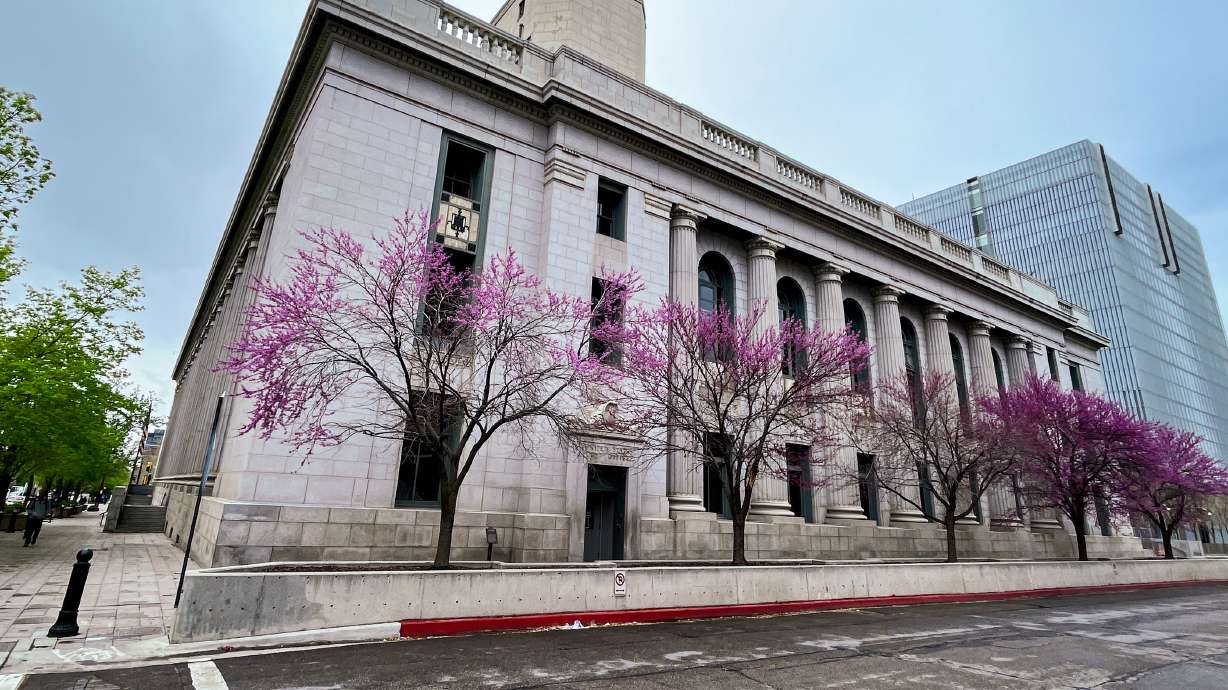Estimated read time: 5-6 minutes
This archived news story is available only for your personal, non-commercial use. Information in the story may be outdated or superseded by additional information. Reading or replaying the story in its archived form does not constitute a republication of the story.
Editor's note: This article is a part of a series reviewing Utah and U.S. history for KSL.com's Historic section.
SALT LAKE CITY — The Frank E. Moss U.S. Courthouse, nestled between chic restaurants and historic buildings repurposed as office space, stands alone on Main Street.
However, historians say that's sort of the point. Its location alone tells a story of a bitter dispute over the growth of Salt Lake City and Utah.
The historic building sits about a block north of where the famed Walker brothers lived beginning in the 19th century, a part of town where the bankers began with a different vision of the city and territory following a falling out with Brigham Young, said David Amott, executive director at Preservation Utah.
"That was a vision of Utah that engaged with the federal government, that would engage with mercantilism, that would connect Utah with the rest of the nation and the American West at that time," Amott said. "They tried to pull the power center of the city from the northern spire-built section of the city to the southern end — and all the buildings that surround this really reflect various people to pull that off."
And amid this battle of ideas, the brothers sold a large block of land to the federal government for just $1 in an attempt to create a new political center closer to the Walker brothers. That deal paved the way for the building at the turn of the 20th century.
The century-old building is now getting its first major upgrade in nearly 90 years so it can remain at the center of the city's judicial sphere. Federal administrators and developers symbolically knocked a wall down inside the structure Friday morning to celebrate the beginning of a massive $116 million renovation and seismic upgrade of the facility.
Once the project is complete, the courthouse will again be home to 12 federal tenants, such as the U.S. Bankruptcy Court and U.S. Citizenship and Immigration Services. That will eventually save about $4.3 million in lease cost avoidance annually for those tenants.
"We are taking a nearly vacant, underperforming building and making smart investments to improve the work environment for these 12 agencies while keeping the historic aspects that make this building special to the people of Salt Lake City," said Tanisha Harrison, the General Services Administration's Public Buildings Service regional commissioner.
The Moss Courthouse was Utah's first building to feature the neoclassical rival style when it was constructed in the early 1900s.
James Knox Taylor, who designed many other federal government structures across the country, designed the building. His life's work included both the Denver and Philadelphia Mint buildings, Ellis Island Immigrant Hospital and countless U.S. Post Office buildings from New York to Alaska. And the courthouse was originally one of those many post offices when it was completed in 1905.

It also served as a court during that time, and its role as such expanded in time as the building did. There were two major additions to the building in 1912 and 1932, which turned its original U-shape into a box and then a figure eight. It landed on the National Register of Historic Places in 1978 along with other components of the Exchange Place Historic District and was eventually named in honor of the three-term Utah Sen. Frank E. Moss in 1990.
It served as the U.S. District of Utah courthouse until a new building opened up west of Main Street, and across the courthouse plaza, in 2014. In a bit of irony, it is now named after Orrin Hatch, who unseated Moss in the 1970s.
The renovation project was first announced two years ago when the federal government approved close to $168 million in infrastructure spending for a pair of Utah projects, the Moss Courthouse and the Internal Revenue Service Center in Ogden.
Tim Gaidis, the senior project designer for the architecture firm HOK, said the design process took about 18 months. Part of the reason it took so long to plan is because the Moss Courthouse became the "most at-risk" General Services Administration building because it is so vulnerable to earthquakes. The seismic retrofit — something that happened at the Utah State Capitol and is currently underway at the Salt Lake Temple — is the main component of the project.
"We're essentially building a building within a building with concrete shear walls and steel cross bracing that will make it safe to inhabit," Gaidis said.
The design also calls for a new accessibility ramp at its entrance and modern enhancements, including a new gallery space on the first floor. But it also seeks to restore historic halls within the building that date back to the start in 1905. A pair of the original courtrooms are also set to be restored, as will be new skylights similar to the old post office over a century ago.

Despite concerns surrounding labor and supply chain shortages, as well as record inflation, the project is still on target to be completed by March 2024. Rob Moore, the executive chairman of Big-D Construction, joked that it may come down to the wire but he expects the "life" to really come back into the building in its final few weeks, especially as construction wraps up and the polishing inside begins.
"I am so excited about this project," added G.W. Emge, the deputy regional commissioner for the Public Buildings Service. "I cannot wait to come back in two years to do the actual dedication."









